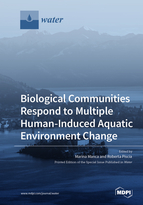Biological Communities Respond to Multiple Human-Induced Aquatic Environment Change
A special issue of Water (ISSN 2073-4441). This special issue belongs to the section "Water Quality and Contamination".
Deadline for manuscript submissions: closed (31 December 2017) | Viewed by 59362
Special Issue Editors
Interests: zooplankton ecology; lakes, ecosystem functioning; Anthropocene; climate change; climate and trophy
Special Issues, Collections and Topics in MDPI journals
Interests: ecology of freshwater zooplankton and analysis of zooplankton resting stages in lacustrine sediment, ecotoxicology, stable isotope analyses, and aquatic food webs
Special Issues, Collections and Topics in MDPI journals
Special Issue Information
Dear Colleagues,
Perturbations linked to the direct and indirect impacts of human activities during the so-called Anthropocene, affect the structure and functioning of aquatic ecosystems to varying degrees. Some of these events stress aquatic life, including soil and water acidification, soil erosion, loss of base cations, release of trace metals or organic compounds, and application of essential nutrients capable of stimulating primary productivity. Superimposed on these changes, climate warming directly impacts aquatic environments via altering species’ metabolic processes, and indirectly by modifying food web interactions. Many stressors interact in a manner that can be difficult to predict. In part, this difficulty arises from the different possible responses by species or entire taxonomic groups to stressors, which may interact additively, synergistically or antagonistically. Entire food webs can be restructured if different trophic levels have consistently different responses to climate warming. However, the consequences of warming-induced changes in food web structure for the long-term population dynamics of different trophic levels remain poorly understood. Such changes may be particularly important to understand in lakes, where food web production is socio-economically important and most organisms are ectotherms that are highly sensitive to changes in their surrounding environment. To understand the degree and mechanisms through which stressors impact lakes biological communities and alter ecosystem, functioning long-term analyses by means of contemporary and palaeo data are essential. Due to its remarkable physical inertia, including thermal stability, global warming is expected to also have a profound effect on groundwater ecosystems. The degree to which alterations can affect aquatic ecosystem structure and functioning also requires the addressing of functional diversity at the molecular level, to reconstruct the role different species play in the transfer of material and energy through the food web. In this Special Issue, we will present examples of the impact of different stressors on aqautic ecosystems and their interactions, providing long-term, metabolic, molecular and paleolimnological analyses.
Dr. Marina Manca
Dr. Roberta Piscia
Guest Editors
Manuscript Submission Information
Manuscripts should be submitted online at www.mdpi.com by registering and logging in to this website. Once you are registered, click here to go to the submission form. Manuscripts can be submitted until the deadline. All submissions that pass pre-check are peer-reviewed. Accepted papers will be published continuously in the journal (as soon as accepted) and will be listed together on the special issue website. Research articles, review articles as well as short communications are invited. For planned papers, a title and short abstract (about 100 words) can be sent to the Editorial Office for announcement on this website.
Submitted manuscripts should not have been published previously, nor be under consideration for publication elsewhere (except conference proceedings papers). All manuscripts are thoroughly refereed through a single-blind peer-review process. A guide for authors and other relevant information for submission of manuscripts is available on the Instructions for Authors page. Water is an international peer-reviewed open access semimonthly journal published by MDPI.
Please visit the Instructions for Authors page before submitting a manuscript. The Article Processing Charge (APC) for publication in this open access journal is 2600 CHF (Swiss Francs). Submitted papers should be well formatted and use good English. Authors may use MDPI's English editing service prior to publication or during author revisions.
Keywords
- Aquatic communities
- ecosystem functioning
- anthropocene
- climate
- trophy
- pollutants
- long-term changes
- plankton







